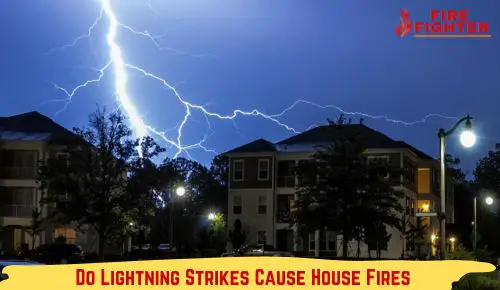Do Lightning Strikes Cause House Fires? Truth Revealed
Lightning strikes are a naturally occurring phenomenon that can be both awe-inspiring and dangerous.
While many people may associate lightning with thunderstorms and flash floods, there is another potential danger that may not be as obvious: house fires.
In this blog post, we will explore the topic of lightning strikes and their potential impact on house fires.
Through examining the science and statistics behind lightning strikes and house fires, we hope to provide a better understanding of the relationship between these two phenomena. So, let’s dive in!
Contents
- 1 Do Lightning Strikes Cause House Fires
- 2 How to Prevent Lightning Strikes Fires
- 3 Is Lightning Used For Anything?
- 4 Percentage Of House Fires Caused By Lightning Strikes
- 5 Cause Of Lightning Strikes Fires
- 6 What To Do If Your House Catches Fire By Lightning Strikes
- 7 What Type Of Lightning Starts Fires?
Do Lightning Strikes Cause House Fires
The answer is yes, they can. In fact, lightning strikes are one of the leading causes of house fires in the United States.
According to the National Fire Protection Association (NFPA), there were an estimated 22,600 lightning-caused fires in the U.S. between 2007 and 2011.
These fires caused an average of $451 million in property damage each year.
One of the biggest dangers of lightning strikes is the electrical surge they can cause.
When lightning strikes a home or building, it can send electricity through the electrical systems.
This surge can damage electrical equipment, overload circuits, and even start fires. In some cases, the electrical surge can cause appliances to catch fire, which can quickly spread throughout the home.

Another danger of lightning strikes is the heat they generate. As mentioned earlier, lightning bolts can reach up to 30,000 degrees Celsius.
When lightning strikes a home, this heat can ignite flammable materials such as wood, paper, and other combustibles. This can quickly lead to a house fire.
You can take some steps to protect your home from lightning strikes.
Installing a lightning protection system is one of the most effective ways to do this.
These systems are designed to divert the electrical surge from a lightning strike away from your home and into the ground.
This can help protect your electrical systems and appliances from damage, and reduce the risk of a house fire.
How to Prevent Lightning Strikes Fires
Preventing lightning strikes fires involves taking proactive measures to minimize the risk of lightning igniting fires. Here are some steps to help prevent lightning strikes and fires:
Install lightning protection systems: Lightning protection systems, such as lightning rods or air terminals, can help to divert lightning away from structures and reduce the risk of a direct lightning strike.
Keep trees and vegetation around structures well-maintained: Overgrown trees and vegetation near structures can provide fuel for fires in the event of a lightning strike. Regularly trim trees, bushes, and grasses to reduce the risk of ignition.
Install spark arresters on chimneys and vents: Spark arresters can prevent embers or sparks from escaping chimneys, vents, or other openings and igniting nearby combustible materials.
Use surge protectors: Install surge protectors on electrical systems, appliances, and other sensitive electronics to minimize the risk of damage or ignition due to lightning-induced power surges.
Avoid using flammable roofing materials: Choose roofing materials that are resistant to fire, such as metal or Class A-rated materials, which can help reduce the risk of ignition from a lightning strike.
Disconnect electrical appliances during thunderstorms: Unplug electrical appliances during thunderstorms to minimize the risk of damage or ignition from lightning-induced power surges.
Follow weather alerts and warnings: Stay updated on weather alerts and warnings, and avoid outdoor activities during thunderstorms to reduce the risk of being struck by lightning.
Properly maintain lightning protection systems: If your property has lightning protection systems installed, ensure they are properly maintained and inspected regularly by a qualified professional to ensure their effectiveness.
Have a fire preparedness plan: Develop and practice a fire preparedness plan that includes evacuation routes, designated meeting points, and emergency contact information in case a fire does occur.
Is Lightning Used For Anything?
Yes, lightning can be harnessed and used for various purposes. Here are some examples:
Electricity generation: Lightning contains massive electrical energy, and researchers have explored the possibility of harnessing lightning for electricity generation.
However, capturing and storing lightning energy is extremely challenging due to its unpredictable nature and high voltage.
Scientific research: Scientists often study lightning to better understand its physics, properties, and effects.
Lightning data collected from lightning sensors and instruments can be used for research in atmospheric science, meteorology, and climate studies.
Medical applications: Some medical researchers have explored the use of small, controlled electrical discharges, similar to lightning, for medical purposes such as tissue healing, pain relief, and wound treatment.
This field of research, known as electro-medicine or electrotherapy, is still in the experimental stage and requires further studies.
Art and entertainment: Lightning has been used as a visual and auditory spectacle in art and entertainment. Photographers and filmmakers often capture lightning strikes in stunning images or videos, and lightning shows or displays are sometimes incorporated into performances or events for dramatic effect.
Lightning protection systems: Lightning rods and other lightning protection systems prevent damage to structures and equipment caused by lightning strikes.
These systems are designed to safely conduct lightning strikes away from the protected structure or equipment, reducing the risk of fire, damage, or injury.
Percentage Of House Fires Caused By Lightning Strikes
According to the National Fire Protection Association (NFPA), an average of 22,600 fires caused by lightning strikes are reported every year in the United States.
These fires result in an average of nine deaths, 53 injuries, and $451 million in property damage annually.
These alarming statistics highlight the need for homeowners to take preventative measures to protect their homes from lightning strikes.
Regarding the percentage of house fires caused by lightning strikes, the NFPA reports that lightning is responsible for approximately 4% of all reported house fires in the United States.
While this may seem like a small percentage, it is still significant when you consider the overall number of house fires that occur each year.
Lightning strikes can occur anytime, but they are more common during thunderstorms.
When lightning strikes a home, it can cause damage in several ways.
The electrical charge from the lightning can cause power surges that can damage electrical appliances and wiring.
Additionally, the heat from the lightning can cause fires in the home’s attic or roof.
Cause Of Lightning Strikes Fires
Lightning strikes fires can be caused by several factors, including:
Ignition of flammable materials: When lightning strikes a flammable object, such as a tree, brush, or building, the intense heat generated by the lightning can cause the material to ignite and start a fire.
Electrical sparks: Lightning can create electrical sparks when it comes into contact with conductive materials, such as electrical wires, transformers, or metal structures. These sparks can ignite flammable materials, leading to fires.
Ground current: Lightning strikes that travel through the ground can create a phenomenon called ground current, where the electrical current travels along the ground, potentially igniting flammable materials in its path, leading to fires.
Ember showers: Lightning can generate embers or sparks carried by the wind and land on flammable materials, such as dry vegetation or roofs, potentially causing fires.
Secondary fires: Lightning strikes can also cause secondary fires by damaging power lines, transformers, or other electrical equipment, which can then trigger fires due to electrical faults, sparks, or other forms of ignition.
What To Do If Your House Catches Fire By Lightning Strikes
If your house catches fire due to a lightning strike, it is essential to take immediate action to protect yourself and your family and minimize property damage.
Here are some steps to follow:
Call emergency services: Dial the emergency services number (e.g., 911) as soon as possible to report the fire and request assistance from the fire department.
Provide your location and details about the lightning strike and any visible flames or smoke.
Evacuate the premises: If you hear the sound of a lightning strike or notice flames or smoke, evacuate the house immediately.
Use established escape routes and avoid using elevators. Stay low to the ground to avoid smoke inhalation, and close doors behind you to help contain the fire.
Alert others: If other occupants are in the house, alert them to the fire and assist them in evacuating, especially if they require help, such as children, elderly individuals, or individuals with disabilities.
Do not re-enter the house: Under no circumstances should you re-enter the house once you have safely evacuated.
Do not attempt to retrieve belongings or extinguish the fire yourself. Leave the firefighting to trained professionals.
Await emergency responders: Once you have evacuated the house, move to a safe location at a distance from the fire, and wait for the fire department’s arrival.
Inform them about the lightning strike and the location of the fire when they arrive.
Follow instructions from emergency responders: Firefighters are trained to handle fires, including those caused by lightning strikes.
Follow their instructions and provide them with any relevant information about the lightning strike and the location of the fire.
Contact your insurance company: Contact your insurance company as soon as possible to report the fire and initiate the claims process.
Document the damages and take photographs or videos of the affected areas for insurance purposes.
What Type Of Lightning Starts Fires?
Lightning can occur within a single cloud, between two clouds, or between a cloud and the ground.
When lightning strikes the ground, it can heat the air around it to temperatures of up to 30,000 degrees Celsius, which can ignite nearby flammable materials.
There are two main types of lightning: cloud-to-ground lightning and intra-cloud lightning.
Cloud-to-ground lightning is the type of lighting that most people are familiar with.
It occurs when a discharge of electricity travels from a cloud to the ground. Intra-cloud lightning, as the name suggests, occurs within a single cloud. Intra-cloud lighting can be just as powerful as cloud-to-ground lightning, but it is less likely to start fires.
So, which type of lightning is more likely to start fires? The answer is cloud-to-ground lightning.
This is because cloud-to-ground lightning is more likely to strike objects on the ground, such as trees, buildings, and power lines.
When lightning strikes an object on the ground, it can heat the air around it, which can ignite nearby flammable materials.
In addition, cloud-to-ground lightning tends to be more powerful than intra-cloud lightning, which means that it can generate more heat and ignite more fires.
Conclusion
Lightning strikes can pose a significant risk of fire and damage to property.
It is essential to take preventive measures, such as installing lightning rods and surge protectors, to minimize the risk of lightning-related fires.
Having a well-designed evacuation plan, with clearly defined escape routes and knowing what to do in case of a lightning-caused fire, is crucial for the safety of yourself and your family.
Remember to prioritize your safety, evacuate the premises, call emergency services, and follow the instructions of trained professionals.
Contacting your insurance company and documenting damages for insurance purposes is also important. Stay vigilant and take necessary precautions to prevent and respond to lightning-caused fires.

Hi, I m Aaron Smith, a firefighter, and creator of Firefighterline.com, a website that provides top-notch training courses for firefighting organizations. After completing my studies, I quickly rose through the fire service ranks, eventually becoming Captain at one of the busiest fire departments in the state.

